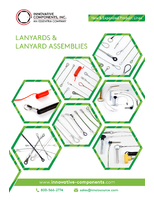HV-HBT Transistors consolidate 3G/4G mobile infrastructure.
Share:
Press Release Summary:
Integrating 2 stages into one package, 28 V HBT (heterojunction bipolar transistor) amplifiers AP631 (4 W) and AP632 (7 W) are suited as pre-drivers and drivers for RF section of base station radio. Linearity minimizes additional signal distortion for repeater applications when used in final amplifier stages and reduces backoff power requirements to minimize distortion from high PAR (peak to average ratio) signals in 3G/4G mobile base stations.
Original Press Release:
Triquint Semiconductor's New HV-HBT Transistors Can Lower Costs of 3G/4G Mobile Infrastructure
New 2-Stage HBT Products Provide Complete RF Solution When Paired With TriQuint's High Power HV-HBT Family
HILLSBORO, OR and ATLANTA, GA (USA) - June 18, 2008 - TriQuint Semiconductor (Nasdaq: TQNT), a leading RF semiconductor manufacturer and foundry services provider, today announced the release of two new HV-HBT (high voltage-heterojunction bipolar transistor) devices created at TriQuint's San Jose, CA design center, formerly WJ Communications1. The highly efficient, highly linear devices expand TriQuint's HV-HBT portfolio, and when paired with TriQuint's high power HBT devices, provide a complete RF solution for 3G/4G high power amplifier (HPA) mobile infrastructure designs. Greater amplifier efficiency can enable lower initial base station costs, lower power consumption and lower operating costs.
"An important customer advantage of the recent WJ Communications acquisition is the ability of the companies' portfolios to complement each other," remarked TriQuint Product Marketing Director, Dan Green. "WJ's device line-up complements our base station portfolio very well. WJ's expertise in InGaP HBT technology and the new devices' excellent linearity, paired with TriQuint's high power, highly efficient and highly linear HBT devices offer a complete RF transistor solution."
The role of highly efficient, highly linear RF transistors in base station amplifier design is critical to enabling network operators' plans for meeting 3G / 4G service demands, Mr. Green noted.
"GSM system amplifiers (2G) don't require linear operation, and their efficiencies were much higher because of this fact. But next-generation 3G/4G systems demand linearity and efficiency, so technology that was well-suited to older network systems suffered a setback when deployed in WCDMA or other next-generation platforms. Consequently, early 3G network operators saw dramatic increases in operational expenses (OpEx) due to the loss of efficiency, so they sought solutions. The more highly efficient and linear nature of HV-HBT products from TriQuint provide the right solution at the right time," said Mr. Green.
A typical RF section in a base station radio is made up of three areas known as the pre-driver, driver and output stages. The relatively low power HBT devices released today by TriQuint are ideally suited as pre-drivers and drivers. TriQuint released its first generation of high power HV-HBT devices in October of 2007. These products serve the driver and output stages and provide exceptionally high efficiency and linearity. When paired with devices like TriQuint's new AP631 and AP632 a complete RF solution is achieved.
"Efficiency at the driver and output stages is especially critical since these components have the greatest impact on minimizing electrical consumption, and play a significant role in reducing the waste heat generated in the RF section of an amplifier," explained Mr. Green. "Because our high power HV-HBT devices are so efficient, they generate about half the waste heat of competing technology in WCDMA systems. Cutting waste heat in half reduces electricity used by cooling systems and also shrinks carbon footprints for network systems operators focused on reducing global warming."
The release of TriQuint's new HBT devices comes at a time of continued growth for highly linear RF transistors in the base station networks market. According to EJL Wireless Research2, the growth in demand for 3G and 4G base stations will result in a higher number of transceiver and therefore power amplifier shipments in the next several years. This research suggests that the 2008-2011 compound annual growth rate (CAGR) for high linearity transceivers will be approximately 35.25%. These systems require highly linear amplifiers, and TriQuint's HV-HBT devices provide this needed linearity with unprecedented levels of efficiency.
The new HV-HBT devices released today at the IEEE IMS MTT-S Convention and Exhibition in Atlanta, GA (USA), integrate two stages into a single package. This allows designers to reduce the number of discrete amplifier components in a system. When used in a typical base station HPA design, a 25% cost reduction and a PCB area savings of 12 square centimeters can be achieved compared to designs using two separate discrete amplifier stages.
The new amplifiers' high linearity minimizes additional signal distortion for repeater applications when used in final amplifier stages, and reduces backoff power requirements to minimize distortion from high PAR (peak to average ratio) signals in 3G/4G mobile base stations. This translates into reduced overall system costs and improved efficiency, which can lower HPA power consumption and improve OpEx (operational expenditures) for multi-carrier 3G mobile infrastructures.
Samples of TriQuint's new high dynamic range 2-stage 28V HBT amplifiers, AP631 (4W) and AP632 (7W), will be available in July 2008 through TriQuint's global sales and distribution channels. Contact TriQuint Product Marketing at: tuan.nguyen@tqs.com / +1 408 577 6318 or visit www.triquint.com for details.
For a detailed list of TriQuint RF products including gallium arsenide (GaAs) power amplifiers and transistors, LDMOS RF transistors, surface acoustic wave (SAW) and bulk acoustic wave (BAW) filters for wide-ranging telecommunications applications, visit www.triquint.com. Register for new product details and to receive our newsletter at triquint.com/rf.
1 TriQuint completed its acquisition of WJ Communications on May 22, 2008.
2 ©2008 EJL Wireless Research, 4th Edition: "Global BTS Transceiver Market Analysis and Forecast, 2007-2012", April 2008.
FACTS ABOUT TRIQUINT
Founded in 1985, we "Connect the Digital World to the Global Network"(TM) by supplying high-performance RF modules, components and foundry services to the world's leading communications companies. Specifically, TriQuint supplies products to four out of the top five cellular handset manufacturers, and is a leading gallium arsenide (GaAs) supplier to major defense and space contractors. TriQuint creates standard and custom products using advanced processes that include gallium arsenide, surface acoustic wave (SAW) and bulk acoustic wave (BAW) technologies to serve diverse markets including wireless handsets, base stations, broadband communications and military. TriQuint is also lead researcher in a 3-year DARPA program to develop advanced gallium nitride (GaN) amplifiers. TriQuint, as named by Strategy Analytics in August 2007, is the number-three worldwide leader in GaAs devices and the world's largest commercial GaAs foundry. TriQuint has ISO9001 certified manufacturing facilities in Oregon, Texas, and Florida and a production plant in Costa Rica; design centers are located in North America and Germany. Visit TriQuint at triquint.com/rf to register for our newsletters.
Mr. Tuan Nguyen
Product Marketing Manager
TriQuint Semiconductor, Inc.
Tel: 408-577-6318
Mobile: 408-396-6432
E-mail: Tuan.Nguyen@tqs.com




